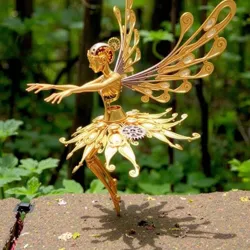Clockwork Sylphs
Clockwork Sylphs are intricate mechanical beings crafted through the art of metalworking and advanced engineering. These creations are a unique blend of artistry and technology, often resembling ethereal creatures forged from metal and powered by complex clockwork mechanisms. Clockwork Sylphs have garnered attention for their beauty, ingenuity, and potential applications in various fields, from entertainment to practical robotics.
Origins
The concept of Clockwork Sylphs dates back to the late 19th century, during a period of fascination with automatons and mechanical devices. Initially, they were conceived as elaborate toys and decorative pieces, showcasing the skills of master artisans in the Eldertree Guild. The intricate design and fluid movements of these early Sylphs captivated audiences, leading to their popularity among collectors and connoisseurs of mechanical art.

Design and Functionality
Clockwork Sylphs are renowned for their exquisite craftsmanship and the seamless integration of mechanical and aesthetic elements. Each Sylph typically features:
- Mechanical Core: A sophisticated system of gears, springs, and levers that animates the Sylph, enabling it to move gracefully.
- Artistic Exterior: Crafted from metals such as bronze and silver, often embellished with jewels and intricate engravings.
- Interactive Features: Some modern Sylphs are equipped with sensors and microprocessors, allowing them to respond to external stimuli or be controlled remotely.
The creation of a Clockwork Sylph requires expertise in industrial metalworking techniques and a deep understanding of mechanical engineering principles. Artisans often draw inspiration from nature and mythology, resulting in Sylphs that mimic the elegance of butterflies, birds, or mythical creatures.
Applications
While initially designed as artistic pieces, Clockwork Sylphs have found applications in various sectors:
- Entertainment: Used in theatrical productions and exhibitions, where their lifelike movements add a magical element to performances.
- Education: Employed as educational tools to teach principles of mechanics and engineering, particularly in transhumanist technology.
- Robotics: Inspiring advancements in the development of biomechanical elements and enhancing the design of humanoid robots.
The adaptability and allure of Clockwork Sylphs continue to inspire innovations in the fields of art and technology.
Cultural Impact
Clockwork Sylphs have permeated popular culture, featuring in literature, films, and video games. They often symbolize the harmony between nature and technology, embodying ideals of beauty and precision. The artistry involved in their creation reflects a broader cultural appreciation for craftsmanship and technological ingenuity.
In communities like the Ironwood Forest, Clockwork Sylphs are celebrated in festivals that highlight the intersection of human creativity and mechanical prowess. These events draw visitors and enthusiasts from around the world, fostering a shared appreciation for the art of metalworking.
Future Prospects
The future of Clockwork Sylphs lies in the integration of emerging technologies, such as artificial intelligence and smart materials. These advancements promise to enhance the interactive capabilities and autonomy of Sylphs, paving the way for new forms of artistic expression and functional applications.
As the boundaries between art and technology continue to blur, Clockwork Sylphs remain at the forefront of innovation, symbolizing the potential of human ingenuity to transform imagination into reality.
See Also
- Eldertree Guild
- Industrial Metalworking Techniques
- Transhumanist Technology
- Biomechanical Elements
- Ironwood Forest
References
- "The Art of Clockwork: A Historical Overview," by M. Tinker.
- "Mechanical Marvels: The Rise of Clockwork Creations," Journal of Robotic Artistry.
- "Integration of AI in Mechanical Art," by L. Gearsmith.